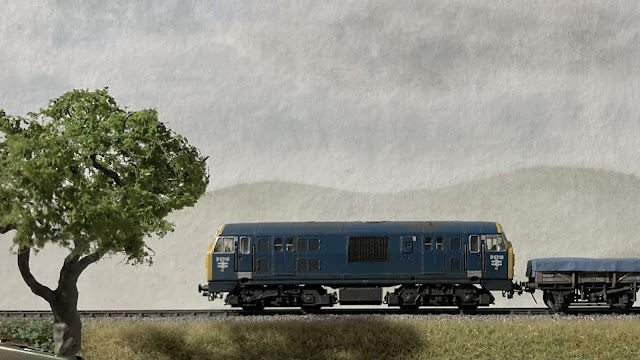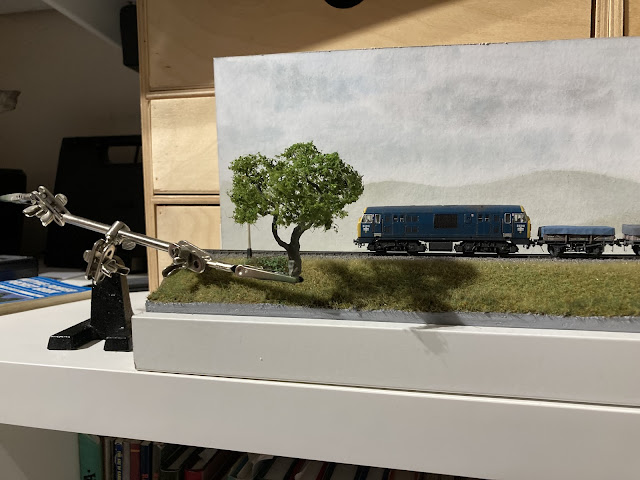From practice comes freedom…
The mix of bought and made is a balance in our craft I’ve discussed recently. Where man-made equates well to repeated mass produced items, nature requires an individual’s touch, and so it is I’m back with my most recent of ‘new skill’ muses, trees…
Chris and I have been sharing a conversation about model railways and railroading now for many years. I shared a few of my recent ‘small oak’ and opened a discussion that helped form a deeper connection with the subject and a personal integration of my methods and craft.
Trees are such a fascinating thing for the way they store and play with light. It seems sometimes modellers wind up with something so dense that it’s opaque.
Indeed. Opaque is too dense. I’m after something that feels closer to my experience of trees here, it is difficult to put in words… When you lie beneath one on a summer’s day, sun shining you’re in the shade gazing up through the canopy. Everything is a myriad of shapes and greens… but always glimpses of the sky.
I know that feeling.
The tree is a beautiful study. Every leaf plays a role of equal value and needs equal access to sun and air. Because of this each leaf reflects it’s piece of light and moves in its stream of breathe.
The oak you see here is only a few inches tall and a ‘test’ twisted copper wire armature in my now tried and trusted method adopted from a mix of Dad’s teaching 30 years ago and Gordon’s tree books. However, on my ‘tree’ journey this one has come out better than all previous. The materials are no different, the methods are not new either - what has changed is me - through practice and a deeper sense of connection to what I am trying to create. A miniaturised version of that same tree canopy experienced time and again in reality.
Wrestling with materials to get them to do what I wanted resulted in something of about the right density first time out the gate but the shape was all wrong and the result wasn’t as pleasing. When I modelled the oak for Paxton Road, probably the tree I’m proudest of to date, I was so worried about hiding the form I opted for a very light coverage of green as if coming into leaf. This time I used both materials but took time to thin the Woodland Scenics foliage pieces more carefully, smaller and observed the shapes of foliage around branches and boughs. Green-scenes flock added a touch of regular shaped ‘leaf’ (vastly over scale but the texture isn’t bad), secured with doses of matt lacquer. A finishing flourish saw some cork based ‘leaf’ material scattered over the canopy, and then mostly removed, still learning.
The photos above show it in relation to the railway, and with colours on the Cambrian micro. Although crafted with no layout in mind it’s form might well suit a coastal location, and I’m pleased with its shape.
It’s easy to curate the blog to appear as if everything always goes to plan. A tree in Gordon’s second book took my fancy as a muse and a break on my current oak tree fascination (more below). This, a maritime pine with its tall spindly trunk and under nourished canopy, appealed greatly. I spent a pleasant hour or so in front of the fire last week making up a series of twisted wire armatures, musing on Gordon’s photos and some of those found on the internet. This was an opportunity to create something quite sparse and in N I fancied the challenge of the light and airy feel of the canopy.
All did not go to plan. This, the worst of the three armatures was selected for ‘experiments’. Gordon suggested static fibres for needles in the larger scales. I used the smallest fibres to hand but had not factored in the impact of the glue on the branches, which then appeared very blobby. As my daughter said, it looks like a cactus (above left). Rather than strip it all off or throw it away in disgust I slept on it, and the next day teased out some Woodland Scenics foliage, although of the wrong shade (oops). Applied this improved matters greatly but the photo showed up my clumsy hand in the trunk shape from applying the PVA/filler mix over the armature (centre). Using a blade this was carved and shaped and then patched up a bit and repainted, and some dark green ‘Green Scenes’ foliage sprinkled on and secured with lacquer (bottom right). This ‘experiment’ will mean I can go straight to the right materials and trust those allowing my hand as an artist to flourish without concern for craft. This is what practice really gives us, freedom to express the beauty of nature in our own hand.
And that’s a wrap (or twist) and above, my oak tree addiction continues unabated as a fourth one slowly takes shape in front of the fire, included here for two reasons. Firstly it shows the raw twisted copper wire form well, and second, shows that we all practice and continue to do so… I hope todays ramblings have helped encourage you with your own projects be they trees or other elements of the hobby. It is through practice alone that we find the confidence to express ourselves. Until next time, more soon…
Donate
I love writing and creating material for the blog. If you enjoy what you read and engage with I would be appreciative of any donation, large or small, to help me keep it advert and restriction free.




Yet another thing I've had a few goes at, but have yet to achieve a satisfactory result. We're pretty much surrounded by trees here, so I really must apply myself at some point.
ReplyDeletePatience, observation and finding an approach that works for you. Try the copper wire method I talk about here, I find it works well especially in N
DeleteMy single core flex arrived today, so I had a relaxing (if not mindful) evening twisting copper strands into a shape that somewhat resembled a tree. This reminds me somewhat of practicing sketching or musical composition; once the physical technique and process become something we can do without too much thought, it becomes a lot less of a struggle to adequately express whatever inspired. On top of that, it's knowing when to stop. Tonight I discovered that applies to tree amatures as well.
ReplyDeleteGreat to hear, well done for persevering.
Delete